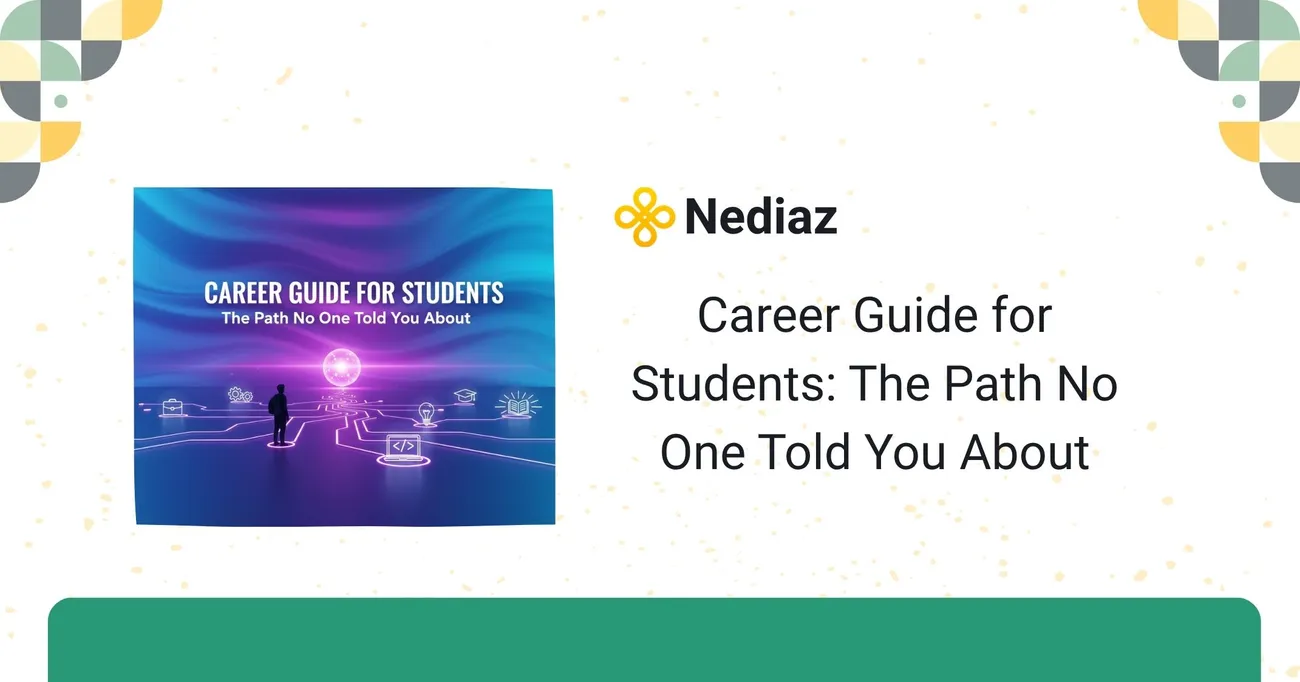
Career Guide for Students: The Path No One Told You About
If you had asked me half a decade ago what the perfect career journey was, I would have handed you a well-organized flowchart along with a list of degrees that I considered most valuable.Today, I’d answer differently. Working life is no longer a linear progression, and that is a positive point - provided one is able to interpret the signals properly. Such people as students, fresh graduates, and junior employees who are fed up with the repeated pattern of giving advice will find this manual useful.
Such people as students, fresh graduates, and junior employees who are fed up with the repeated pattern of giving advice will find this manual useful. You know the lines: study hard, get internships, land a job. That’s not wrong. But it’s incomplete. I’ll walk you through practical steps that aren’t often taught in class: how to explore unconventional options, build job readiness, and grow professionally even when the path is messy.
Throughout this post you’ll find student career advice, common mistakes to avoid, and simple exercises to try. I’ll also show how to think about future careers in a way that actually helps you make decisions right now. No fluff. Just stuff that works.
Why the usual career advice falls short
Most career planning advice assumes there is a right path for everyone. Pick a major, follow a checklist, and you’ll be fine. Reality rarely matches that neat story. Employers look for adaptable candidates. Industries change every few years. Your interests will shift. If you build your plan around certainty, you’ll hit a dead end sooner or later.
Based on my experience, students who achieve the most success are those who not only have a plan but also experiment. They consider careers as experiments: form a hypothesis, test, measure, and repeat. This is by far a better model than just blindly following a single "safe" title.
The reality is: career growth is disorderly, non-linear, and very intimate. Hence, this guide is all about the resources and habits that you can still be using in 20 years rather than a roster of positions that might disappear next year.
Start with three simple questions
Thinking of creating a resume or applying for internships? First, reflect on these three questions. They are elementary, yet they have a profound effect on the way you plan your career.
- What do I enjoy doing for hours? Think of tasks that make time disappear. Don’t limit this to paid work. Do you enjoy tinkering with code, editing videos, organizing teams, or explaining ideas to others?
- What am I reasonably good at? Be honest. You don’t need to be an expert, but you should have a starting level of skill. Often, the overlap between enjoyment and competence is where you’re going to grow fastest.
- Where is the market for that skill? Look for industries or roles that need what you can do. This step is about direction, not finality. You can pivot later.
Answering these helps you avoid chasing prestige over fit. I find students often pick careers based on a title rather than the daily work. Don’t be that person. Pick the work first.
Explore, don’t commit
Exploration beats premature commitment. You don’t need to have everything figured out. Instead, sample options cheaply and quickly. Think of this like tasting dishes at a buffet before ordering the full plate.
- Just take a brief online course to check your interest.
- Offer your help and service on a project that requires your expertise.
- Request an hour of someone's time for an informational interview and bring up points you prepared.
These low-cost experiments tell you more than a year-long internship might.A student that was convinced they hated marketing, I once told them to consider a micro-internship. After only two weeks of assisting with social media analytics, they found that they really loved data-driven storytelling. That one experiment changed their major and trajectory.
Map your skills, not just your resume
Resume skills are a start, but a skills map helps you see transferability. List hard skills, soft skills, and tools you use. Then connect them to real tasks and roles.
Example: If you know Excel, data cleaning, and presentation skills, you could be valuable in analytics, operations, or product roles. Seeing these connections helps you apply to more roles with confidence.
Here’s a quick exercise I recommend to students: write down five projects you’ve done, list the tasks you did for each, and then group those tasks into skill buckets. You’ll be shocked at how many marketable skills you already have.
Build job readiness with micro-projects
Employers care about what you can do, not what a class says you learned. Micro-projects are short, focused tasks you can complete in a week or two that show competence.
Examples are simple:
- The first on the list is to create a report containing three slides based on the publicly available data.
- The next one is to design a small landing page to promote a friend’s side hustle.
- Following that, you need to write two blog posts about a topic that you want to research.
- Furthermore, you can run a small A/B test on an email campaign for a campus club.
Make sure these projects are visible on your LinkedIn and portfolio. When you meet with hiring managers, you will have real examples to talk about. During interviews, being specific is more effective than making vague statements.
Network without the awkward small talk
Networking feels fake to many students. We have all been given a networking checklist that looks like "Attend an event, hand out business cards, follow up." However, that seldom works. Rather, concentrate on adding value and building authentic connections.
Put this method to work:
- First, find out the people whose work is interesting to you.
- Then, reach out with a definite request, like requesting a book recommendation or just one resource concerning their workflow.
- Give something valuable to the person in return: an article, a contact, or a brief summary of what you have learned from their work.
Personal, honest communication, no matter how small, leads to connections. I have seen students who have landed job interviews just because they took the initiative to follow up on a suggestion and shared how they implemented it. It is not magic; rather it is consistency.
Use internships strategically
Internships are valuable, but many students treat them as requirements instead of experiments. Don’t take an internship just for the name on your resume. Use internships to test an industry, build skills, and add real work to your portfolio.
Here’s how to get more from an internship:
- Set 2-3 learning goals before you start.
- Ask for projects that let you own outcomes, not just complete tasks.
- Track your achievements in a simple document you can reuse in interviews.
One common mistake I see is staying in a role because it looks safe, even when the work doesn’t align with your goals. If the internship isn’t moving you forward after a month or two, have a conversation or find another experiment to run.
Build a portfolio that tells a story
A portfolio is more than a collection of samples. It should tell the story of who you are, how you solved problems, and what you learned. Keep it concise, and highlight impact.
Structure each portfolio entry like this:
- Context: What was the problem?
- Role: What did you do?
- Actions: Which steps did you take?
- Outcome: What changed because of your work?
Use numbers when you can. Saying "I improved engagement" is ok. Saying "I increased email open rates by 18 percent in four weeks" is better. If you don’t have numbers, describe qualitative impact and feedback.
Interview like a problem solver
Most interviews are a test of problem solving. Even when they ask behavioral questions, they want to see how you think. Prepare by practicing short stories that show your approach to work.
My recommended framework for answers:
- Briefly set the stage.
- Explain the challenge you faced.
- Describe what you did and why.
- Share the outcome and what you learned.
Keep answers concise. Don’t tell your life story. People hiring want examples that show you can handle the job. Practice with a friend or record yourself to tighten the delivery.
Make mentors work for you
Mentorship is often treated like a one-sided favor. I’ve noticed the most successful students treat mentorship like a small-team project. Be intentional about how you ask for help.
Useful steps:
- Ask for specific, limited support. Instead of "Can you mentor me?" try "Can we meet once a month to review two job applications?"
- Prepare what you want to discuss. Mentors will appreciate that you’re not wasting their time.
- Show progress between meetings. Even small wins matter.
People are more likely to help when they see you acting on advice. Mentorship is a relationship. Treat it like one.
Think in skills, not jobs
Jobs come and go. Skills last. If you focus on building transferable skills, you’ll have options later. Those skills fall into three buckets: technical, human, and business-savvy.
- Technical skills include coding, design, data analysis, and tools like Excel, Figma, or Python.
- Human skills are communication, facilitation, and leadership.
- Business savvy means understanding metrics, market fit, and how your work affects revenue or outcomes.
Pick one skill from each bucket and strengthen it. That combination will make you valuable in many future careers.
Side projects beat wishful thinking
Side projects are the easiest way to test an idea and show initiative. They also teach you how to ship a product from concept to reality — an underrated skill in any industry.
Keep projects short and outcome-focused. A two-week app prototype or a month-long blog series is better than a vague "I want to launch a startup." Side projects give you talking points in interviews and real work to show employers.
Common mistakes students make
I want to be blunt here. These are mistakes I see repeatedly. Avoid them, and you’ll save time and frustration.
- Applying without customizing applications. A generic application looks like you didn’t care.
- Boasting without proof. If you say you led a project, show what changed because of your leadership.
- Following prestige over fit. That fancy company might not teach what you need.
- Ignoring mental health. Burnout kills momentum, especially when you’re early in your career.
- Waiting for permission. You don’t need someone to sign off on your experiments.
These are simple traps. People fall into them because they want security. But security comes from being adaptable, not from clinging to a single title.
Evaluate opportunities like a pro
Not every offer is worth taking. I use a simple rubric to evaluate roles:
- Learning: Will I learn something valuable in the next six months?
- Ownership: Will I own outcomes or just complete tasks?
- People: Are the people around me helpful and curious?
- Fit: Does the role match my short-term goals?
If a job checks 3 out of 4, it’s probably worth considering. If it only wins on salary, pause and ask what you’ll gain beyond money. Salary is important, but it’s not the only factor in long-term growth.
Think of lateral moves as progress
Many students think progress means upward moves only. That mindset misses lateral moves that build new skills and open fresh options. A sideways step into product operations or sales engineering can lead to leadership roles faster than a slow climb up a narrow ladder.
Here’s a simple rule I use: if a move multiplies the number of future options you have, it’s a good move. If it narrows your future, be cautious.
Freelancing and gig work as a learning lab
Freelancing can be a real learning lab. It teaches client management, pricing, and how to ship under constraints. Start small: say yes to a weekend gig or a short project that pays a modest fee.
Lessons you’ll learn quickly:
- How to scope work so clients don’t expand the project.
- How to price work so you don’t undercut yourself.
- How to collect testimonials and referrals.
Even if you don’t freelance long-term, the skills you gain are immediately useful in full-time roles. They teach you accountability and customer focus.
How to keep learning when school ends
Graduation doesn’t stop learning. If anything, it makes self-directed learning more important. Build a learning habit that fits your schedule. It might look like one hour a day or two deep work sessions per week.
Choose learning that directly connects to projects. Learn SQL because you want to analyze a dataset for a portfolio piece. Take a UX course because you want to redesign a nonprofit’s website. Context beats consumption.
read more : Top High-Paying Jobs in Engineering You Should Know About
Plan for uncertainty
The future is uncertain. Economic cycles, technology shifts, and global events change the job market overnight. I recommend a simple "resilience buffer" strategy:
- Keep three months of basic expenses saved when possible.
- Maintain two marketable skills at all times.
- Build a network of people in adjacent fields who can share opportunities quickly.
This isn’t meant to be scary. It’s practical. A small buffer and diverse skills keep you flexible when markets wobble.
Real examples: students who took the path less traveled
I want to share two short stories to make this real.
Case 1: Priya, engineering major. She liked coding, but she hated long software sprints. She tried product design for a semester and liked the human side of building products. Instead of switching majors, she took design electives, built a design portfolio with three small redesigns, and applied for product design internships. She didn’t land a role at a top tech company right away, but she found a startup where she could touch both code and UX. Two years later she leads product for a B2B tool.
Case 2: Marcus, business student. He wanted to start a company but had no product. He offered to run growth experiments for a campus nonprofit. In three months he increased sign-ups by 40 percent and documented the playbook. That micro-project became his first consulting client post-graduation and later led to a remote role at a marketing agency.
Both students used small experiments to redirect their careers. The key was action, not waiting for permission.
Quick exercises you can do this week
Don’t wait to act. Here are five quick exercises you can complete this week to get momentum.
- List five projects you could finish in two weeks and pick one to start.
- Send three short emails to professionals asking for a 20-minute chat. Keep it specific.
- Update your LinkedIn headline to reflect the skill you want to be hired for, not just your major.
- Create one portfolio entry using the context-role-actions-outcome structure.
- Read one industry report or newsletter and summarize three trends that matter to your target role.
Small actions compound. Pick one, do it well, and the rest follows.
Read more : The Rise of Educational Technologists: How Tech Is Redefining Learning in 2025
Tools and resources I recommend
You don’t need every tool. Use a few that fit your goals.
- Notion or Google Docs for tracking projects and accomplishments.
- LinkedIn for networking and company research.
- Github or Behance for your portfolio depending on your field.
- Coursera, Udemy, or similar platforms for targeted skill-building.
Don’t get stuck collecting tools. Use them to ship work and show results.
How Nediaz can help
At Nediaz, we built tools and coaching to help students and young professionals navigate this messy career landscape. If you want to test career ideas, build job readiness, or run targeted experiments with support, we can help you get focused faster. I’ve seen students shorten their job search by months when they pair smart tactics with real feedback.
Final thoughts: your career is a series of choices, not a single decision
One of the things I tell students is this: treat your career like a series of experiments. Make small bets, measure outcomes, and be ready to iterate. You don’t need to pick the perfect path right now. You need a repeatable approach to choose, test, and adjust.
If you leave with one practical idea from this guide, let it be this: build and show. Build small projects that teach you and show those projects to people who can help you take the next step. That habit will serve you better than any single degree or Fast Job Hunting Made Easy Through Social Media Networking in 2025title.
Helpful Links & Next Steps
Want help applying these steps to your situation? Book a free demo today and we’ll walk through a simple plan you can start this week.

